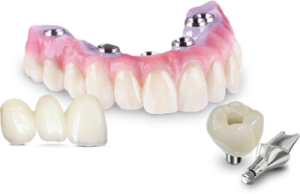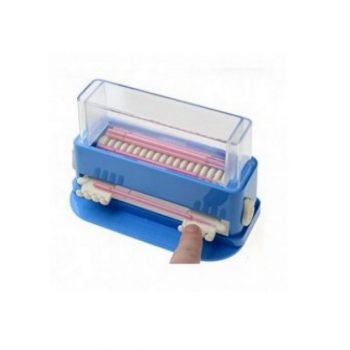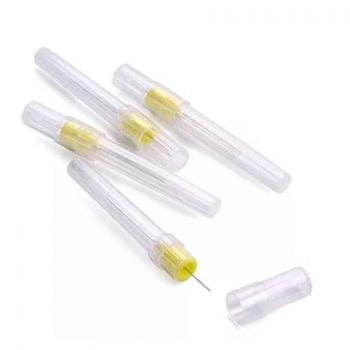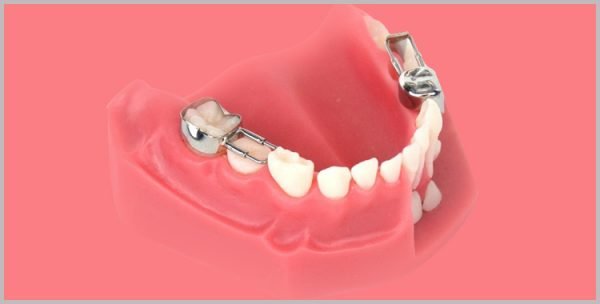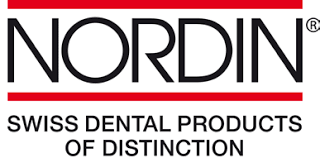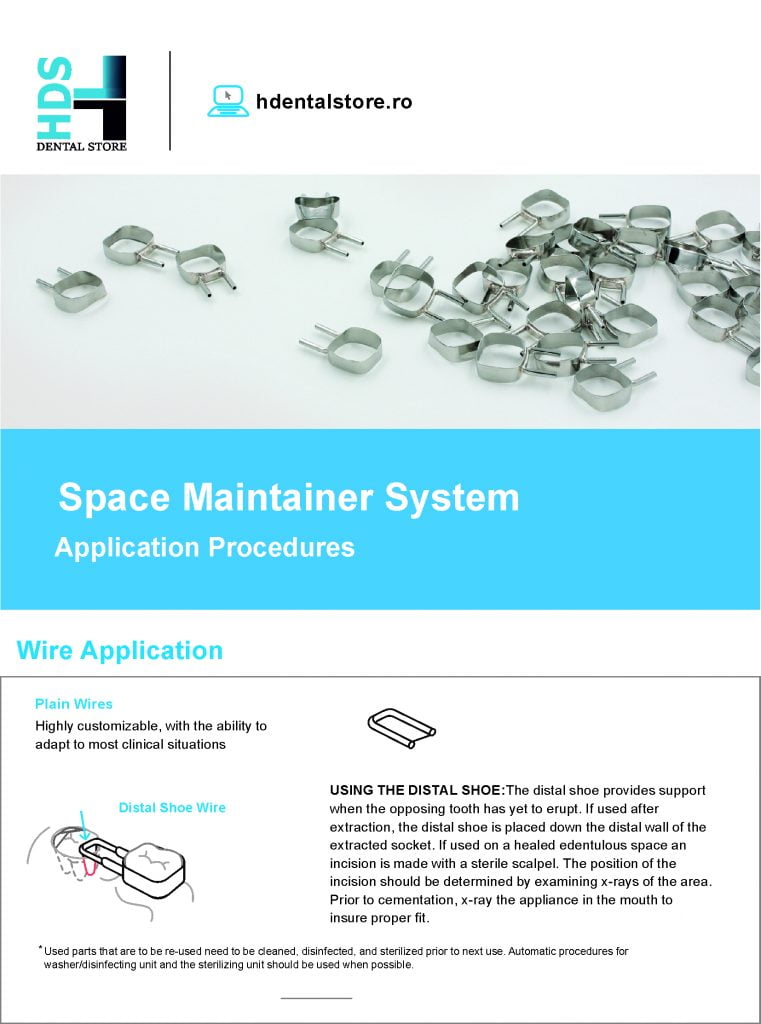
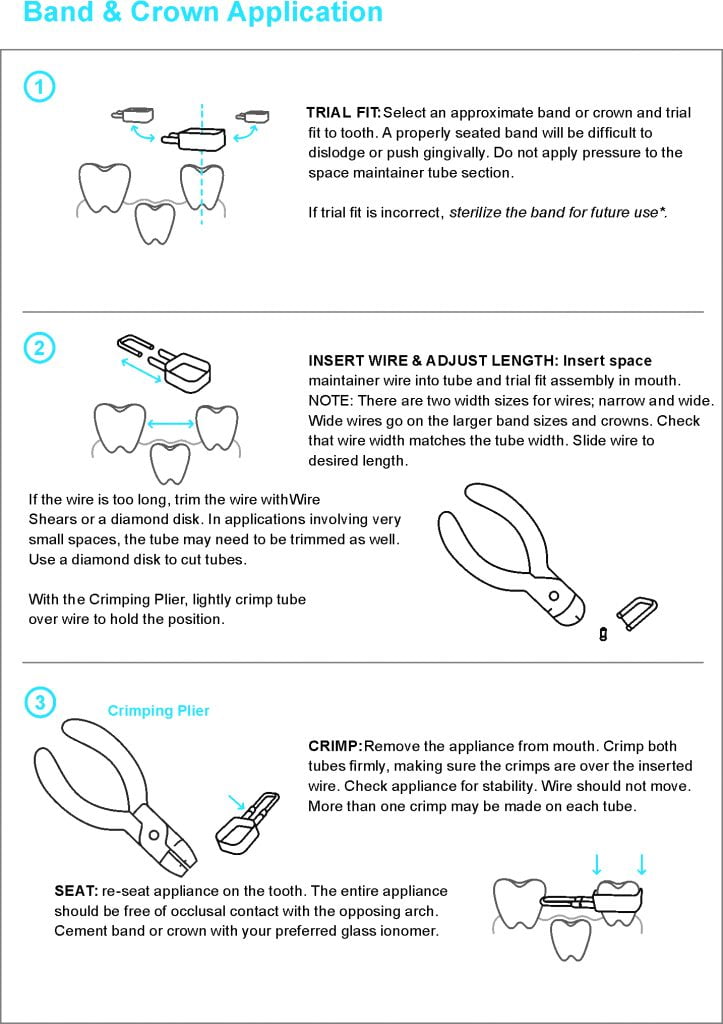
Introduction
Space management refers to the careful supervision of the developing occlusion throughout the primary and mixed dentition stages of development. With appropriately timed maintenance of existing arch space, the clinician may reduce or eliminate the need for future orthodontic treatment. While many different types of appliances and treatment modalities exist to manage space in the primary and mixed dentitions, this article will focus exclusively on the use of the band and loop space maintainer secondary to the premature loss of a first and/or second primary molar.
Background
In the past, space maintenance was often thought of as treatment for a specific problem, that is, the use of an appliance to hold space for a developing unerupted permanent tooth necessitated by the premature loss of a primary tooth. More recently, however, space maintenance is thought of as an ongoing process involving broader diagnostic factors that continues throughout a patient’s growth period. Therefore, the use of the term space management more accurately describes the fact that the patient’s overall occlusion should be evaluated and that occlusal growth and development must be considered before an appliance is placed in the child’s mouth.
Even today, from both parents’ and various dentists’ point of view, space maintenance has created frustration and gained a poor reputation overall. Lost appliances, repeated broken appliances, failure to maintain arch length and unrealistic expectations on the part of certain parents have been the most common complaints. Proper diagnosis and case selection, thoughtful appliance design, and parent education as to the value, limitations and responsibilities with regard to the appliance are the keys for successful space management.
Obviously, the ideal space maintainer is the tooth itself. Pulpotomies and non vital tooth therapy can help in the restoration of primary teeth but unfortunately many patients still suffer the untimely loss of these teeth. In these cases of early primary tooth loss subsequent shift and/or drift of adjacent teeth into the edentulous space, can occur and negatively affect the stability of the dentition.
Diagnosis of Space Maintenance
When a child patient who has prematurely lost a primary molar or several primary molars is examined, the first step taken to establish the need for space maintenance is to determine the presence or absence of the successional tooth. Once the presence of the permanent tooth has been established, measurements should be taken to determine the space necessary or available for the successional tooth. If the patient has only a primary dentition, then no measurements are necessary. If the child is over eight years old and permanent incisors are present, a mixed dentition analysis should be completed as part of the diagnosis for space maintenance. This analysis will indicate the adequacy of the dentition to accommodate all the successional teeth. This is extremely important, for it is discouraging for the clinician to maintain space if the space available is inadequate in the first place. The parents of children usually expect their child to have straight teeth if space maintainers are utilized. The dentist must also determine at this time whether the patient has an existing malocclusion that may require orthodontic treatment in the future. That is, the dentist should consider as to whether the space he/she decides to maintain may necessarily have to be closed subsequent to future orthodontic extractions. Both of these considerations will become extremely relevant in the nine to eleven year-old child age group, when arch length availability is critical.
General Guidelines for the Use of Space Maintainers
If the maxillary or mandibular primary central incisor(s) is lost prematurely after the eruption of the primary lateral incisor but before the eruption of the primary cuspid, a space maintainer is necessary.
If any anterior primary teeth are lost prematurely after the eruption of all primary teeth, space maintenance is not necessary. However, it may be desirable from an aesthetic, phonetic, masticatory or a habit prevention aspect.
If the first primary molar is lost before the eruption of the first permanent molar, a space maintainer is necessary.
If the first primary molar is lost after the eruption of the first permanent molar, but before the eruption of the permanent lateral incisor, a space maintainer may be necessary.
If the second primary molar is lost before or after the eruption of the first permanent molar, a space maintainer is necessary.
If the first and second primary molars are lost before or after the eruption of the first permanent molar, a space maintainer is necessary.
If the second primary molar is lost after the eruption of the first permanent molar but before the eruption of the second permanent molar which is erupting ahead of the second bicuspid, a space maintainer is necessary to avoid space loss and impaction of the bicuspid.
If the second primary molar is lost after the eruption of the first and second permanent molars, then a space maintainer is not usually required.
N. B. Whenever a permanent tooth is lost, with the exception of the third molars, some type of space maintainer or prosthesis is indicated in order to preserve the integrity of the arch and the established occlusion until a permanent prosthesis is placed. If the patient is undergoing other treatment (e.g., orthodontics), then space maintenance requirements would be altered accordingly.
Considering the above guidelines, we will now discuss the fabrication of the band and loop type space maintainer. This fixed appliance can be used to maintain space, either unilaterally or bilaterally, following the premature loss of a primary or secondary molar.
Procedure
The steps involved in the fabrication and placement of the band a loop space maintainer are:
• Band selection and placement
• Impression
• Model fabrication and lab work
• Cementation
The following special instruments are used in the fabrication and placement of the band and loop space maintainer:
• A mouth mirror
• An explorer
• Band seater
• Band burnisher
• Band removing pliers
• A scaler type instrument
• And a sectional impression tray
• Prophylaxis equipment
• Flour of pumice
• And a band cementing material
• Band Selection
A preformed stainless steel band is selected to snugly fit the abutment tooth of the space maintainer. Finger pressure may be used for initial band placement while final occlusal-gingival seating is achieved with the use of a band seater. By applying pressure to the occlusal aspect of the band using the band seater and the patient’s biting force one is able to drive the band gingivally. A burnisher may then be used to achieve the final adaptation of the band onto the grooved surfaces of the tooth. The correctly fitted preformed stainless steel band is seated out of occlusion, is difficult to displace and displays no voids between the band margin and the abutment tooth surface.
Impression
Once the band is selected and appropriately placed, the operator is required to take an accurate impression. This impression should, at a minimum, include the abutment tooth with the fitted band in place, the edentulous area, and the tooth anterior to the edentulous area. A sectional impression tray is then loaded with either alginate or compound and the impression is taken. Once the desired set of the impression material is achieved, the impression may be removed and examined for appropriate detail. If the impression is satisfactory, the band may be removed using a band removing plier or a scaler type instrument. The band should then be placed in the impression and stabilized using wax and a heated wax knife. It is essential that the band is secure within the impression prior to model fabrication as a band that is easily displaced will lead to an ill-fitting space maintainer.
Model and Loop Fabrication
Following band stabilization, dental stone is poured into the impression in order to produce a working model. Once the stone has achieved its full set, the working model may be separated from the impression and loop fabrication may begin. The loop is comprised of a 0.036 inch stainless wire that is contoured to fit the band and edentulous space.
A properly contoured loop will
• parallel the edentulous tissue space,
• lie approximately 1mm above the gingival tissues,
• reach the distal surface of the tooth anterior to the edentulous space just below its contact point,
• have sufficient width buccal lingually to permit unobstructed eruption of the permanent tooth,
• and should not impinge on either the tongue or buccal mucosa.
Once all of these criteria have been satisfied, the loop, initially held in place using sticky wax, can then be permanently soldered to the band and polished.
Cementation
Prior to cementation, the band and loop should be tried in to ensure that it fits the tooth and edentulous space as intended. It should also be confirmed that the band and loop does not interfere with the patient’s occlusion. While minor adjustments may be made to the loop using orthodontic pliers, a grossly ill-fitting space maintainer should not be inserted. In these instances of poor fit, the previous steps should be repeated until a satisfactory result is achieved. Once the appropriate fit is achieved, the abutment tooth should then be pumiced, rinsed, dried and isolated. The band is then loaded with cement to cover all internal surfaces and as few as possible external surfaces. On insertion, the band must be positioned onto the abutment tooth in exactly the same manner described in the fitting procedure, using both finger pressure and a band seater. Additional burnishing of the band margin against the abutment tooth surface can then be completed following final band seating. Following the final adaptation of the band margins excess cement is then removed from the occlusal surface, the gingival crevice, and all other hard and soft tissue surfaces in the oral cavity.
Maintenance and Evaluation of Fixed Space Maintainers
Patients with the band and loop space maintainer must be evaluated at recall appointments to reassess the fit and stability of the appliance as well as the patient’s oral hygiene. The degree of eruption of the permanent tooth for which the space is being maintained must also be assessed. Parents should be made aware of this and should contact the dentist at the first sign of any looseness, change in the appliance, or complaint from the patient as untreated appliance failure may necessitate more complicated treatment in the future.
Appliance Removal
The impending eruption of the permanent tooth for which the space is being maintained is an indication for appliance removal. Impending eruption may be determined using clinical and/or radiographic evidence whereby the occlusal surface of the succedaneous tooth is shown to have reached the alveolar crest. Once the desired eruption of the succedaneous tooth is achieved, the band and loop space maintainer can be removed using the band removing pliers.
References:
Sigal MJ, Rukavina J. Occlusion. In: Sigal MJ, Rukavina J, eds. Pediatric dentistry manual. 9th ed. Toronto: Faculty of dentistry, Department of pediatric dentistry, University of Toronto, 2006; 251-305.




















